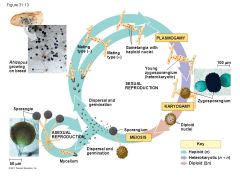![]()
![]()
![]()
Use LEFT and RIGHT arrow keys to navigate between flashcards;
Use UP and DOWN arrow keys to flip the card;
H to show hint;
A reads text to speech;
21 Cards in this Set
- Front
- Back
|
Fungi are ________ that feed by __________ and __________ |
heterotrophs; extracellular digestion; absorption
|
|
|
Chitin |
a fibrous substance consisting of polysaccharides and forming the major constituent in the exoskeleton of arthropods and the cell walls of fungi. |
|
|
Perforated Septa |
hole in the wall of the cell |
|
|
Coenocytic fungi |
lack septa and have a continuous cytoplasmic mass with hundreds of thousands of nuclei |
|
|
Hyphae (S and F) |
S: a chain of fungal cells end to end F: extracellular absorption (feeding/growth) |
|
|
Fruiting Body (S and F) |
S: hyphae reconfigured F: reproduction/spore bearing |
|
|
Haustoria (S and F) |
S: specialized hyphae
F: allow them to penetrate the tissues of host |
|
|
Plasmogamy |
what results when mycelium fuse with another hyphae (+ and -) |
|
|
Heterokaryon |
formed by plasmogamy |
|
|
Dikaryon |
formed by plasmogamy |
|
|
Karyogamy |
what happens when nuclei fuse |
|
|
Mycorrhizae |
fungus that lives within the root system of plants |
|
|
asexual reproduction is by fragmentation or the formation or the formation of _________ , smalll clusters of hyphae with embedded algae |
soredia |
|
|
Mycosis |
the general term for a fungal infection in animals
|
|
|
Endophytes |
fungi that live inside leaves or other plants |
|
|
Lichen |
a symbiotic association between a photosynthetic microorganism and a fungus
|
|
|
Pioneer Species |
new species to a specific area |
|
|
What are the closest relative to fungi? |
animals and some protists |
|
|
Why are fungi so important? |
they are nutrient recyclers, mutualist, pathogens, human use (food, antibiotics, genetic research, bioremediation) |
|
|
When did fungi arrive? |
about 460 million years ago |
|
|
Life Cycle of a Fungus |

|

